|
The diatomist John Albert Long (1863 - 1945*):
Notes on aspects of his life and work with examples of his prepared slides.
by David Walker, UK
Image right: Long in 1882 as a student at the Chester Diocesan Training College.
(Detail from the 1882 students' class photo, courtesy of Cheshire Archives and Local Studies, ref. ZCR
86/17/19.)
|
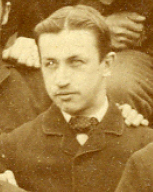
|
* Some published records dating the year of death as 1944 are discussed.
In the Explorer browser, setting to 60% size in Print Preview, with 'Only the Selected Frame'. prints to 14 pages of A4.
Prepared diatom microscope slides attributed to 'J A Long' may be found in collections or for sale, and until recently I had three single species slides. An opportunity to acquire an exhibition arranged slide and examples of systematic arranged slides all complete with Long's original species lists, prompted me to learn more about this slide maker. He was also a fellow 'West Yorkshireman'
living not far from my own home which added an extra aspect of interest.
Brian Bracegirdle in his invaluable book 'Microscopical Mounts and Mounters' (1) has an entry for Long who notes that he was "a well-known diatom mounter" and that "His slides are still highly regarded.". An eloquent Obituary written by the famous diatomist Norman Ingram Hendey (2a) was published in the Journal of the Royal Microscopical Society (2) and reflects the high regard
in which both
the man and his work were held; Hendey
remarks:
"As a preparer of diatom slides he ranks among the best ever produced in this country ..." and later
"He was one of the last of an old school of diatomists who are fast disappearing, and he corresponded with other diatomists all over the world."
The images below of my own slide examples show some typical slide forms and his skills at preparing single species and arranged slides, supplemented by notes on aspects of his life and work.
Family and work background
Ancestry records (3) and other online searches reveal aspects of his background and is presented here supplemented by details from Hendey's Obituary. John Albert Long was born in Yeadon on January 25th 1863 (13) to Edmund Long and his wife Ruth (a widow). Yeadon is a small town NW of the city of Leeds, West Yorkshire, UK. The 1871 census shows John aged 8 living at 9 Moor Lane, Yeadon with his parents
and his mother's three
son-in-laws from a former marriage (to Dawson).
The men in
the family, as were most of their neighbours, were heavily involved in the textile industry, one of the key industries in this area of northern England at the time. John's father is a 'warpdresser' and his mother's son-in-laws have textile trades, as did his mother before remarriage.
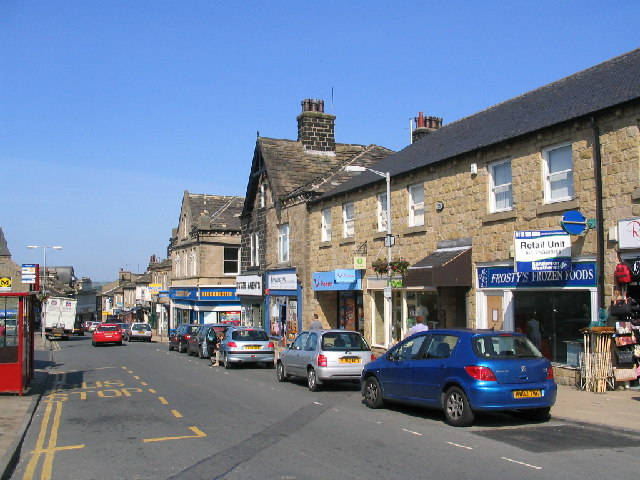
The High Street today in Yeadon, W. Yorkshire the town where Long was born.
Image credit: © Copyright Mick Melvin and licensed for reuse under this Creative Commons Licence
Image source: the 'geograph' website at http://www.geograph.org.uk

The Chester Dicoesan Training College which Long attended.
Image credit: Hosted by Wikipedia and cited to be in public domain, sourced from the University of Chester 'Media Pack'.
Wikipedia caption: 'A drawing of the University of Chester's original building (still in use and now known as Old College) in 1843, a year after it opened.'
The 1881 census shows John (aged 18) to have left home and now a student at the 'Chester Diocesan Training College', Chester St Oswald. This college, founded in 1839, has a prestigious history which is well documented online (4) and offered a range of subjects. It was a founding college of the University of Chester and its Alumini website
notes that it was "the UK's first purpose-built teacher training college - making
it one of the oldest higher education institutions in the country". Both John's parents families also worked in the textile industry, so John's teacher training is a departure from the family's work background. The College is over 70 miles west of his home and it would be interesting to explore the archives of the
College held at the Cheshire Record Office to see if John attended under a scholarship or exhibition, perhaps from evidence of academic achievement at school.
Update March 2012. Searches of the Chester College records ca. 1880s by the Chester Archive staff have been carried out. A photograph of the students in 1882 was found, shown below and a close-up of Long in article header. From the records, Long was confirmed as a student in the two year course spanning 1881-1882 (see Footnote 3). Apart from noting that Long passed his exams during the course, no other details of his stay are recorded in the extant College archives (17).
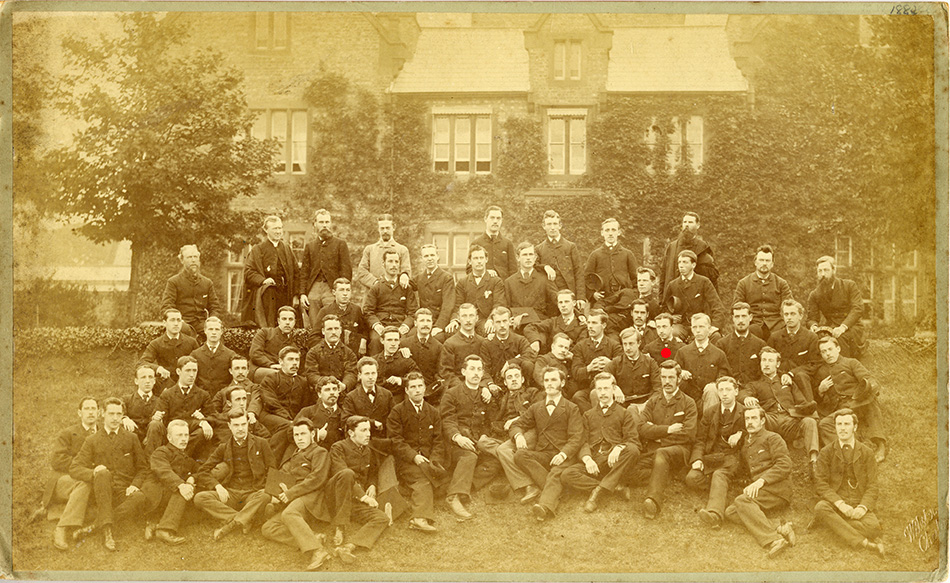
John A Long (marked with red spot) in the students' class photo dated 1882 taken at the Chester Diocesan Training College. See article header for close-up. (Student's were identified by name on a copy of the image.) The older gentlemen along the back row, some gowned, are probably the teachers.
(Image copyright and with permission of Cheshire Archives and Local Studies, ref. ZCR 86/17/19.)
By 1891 John Long had begun his teaching career and was living at 14 Station Road, Burley and married to Martha Ann (née Gill, born in Guiseley, they married in 1889). They had a daughter Alice born in 1891. He is described as an 'Elementary Teacher Certified Assistant'. Martha died in 1897 but John married Grace (née Clapton) in 1898. In 1901 John and Grace were living at 6 Westgate Hill, Tong (a village suburb
of Bradford) and had a second daughter Edith by Grace.
The 1901 census describes John as a 'Schoolmaster' and in the 1911 census as an 'Elementary Teacher'; although in his obituary Hendey notes:
"In 1898 he became headmaster at Westgate Hill School in Bradford and remained there until he retired in 1923."
His second wife Grace died in 1908 but in 1911 he married Fanny E Gransby (Grace's widowed sister (3a)). The 1911 census shows them living at the Tong address with John Long's daughter Edith.
In the 'Micro-Notes' 1948 of the State Microscopical Society
of Illinois, there is the following Obituary, which may suggest a former close association of John Long with the Society.
"We regret to announce the death of the wife of the late John A. Long, last February, 1947 after a short illness. As known
to diatomists all over the world, Mr. Long was
one of the most skilled and generous workers."


Kelly's Directory for Bradford 1901, showing John A. Long as 'head teacher' of the 'Mixed' part of the Westgate Hill School.
(Page entry truncated for clarity.)

Menston today (showing the Main Street), the town in W. Yorkshire where Long lived in later life and from which most of his slide labels are addressed.
Image credit: © Copyright Gordon Hatton and licensed for reuse under this Creative Commons Licence
Image source: the 'geograph' website at http://www.geograph.org.uk
Public census records cease in 1911 and uncertain when he moved from his Tong address to Menston. Apart from his teacher training, the addresses noted above where John Long lived, are all within a 7 mile radius of his birthplace. The 'Menston, Leeds' address is the only one I've seen to date on microscope slides and would be interested to hear of any other examples. John Long died on June 5th 1945 aged 82 from
natural causes at his Menston
home ('Mayhurst', Upper Cleasby Road) (14) and Hendey notes that his interest in diatoms spanned from 1900 to shortly before his death and that he was elected to Fellow of the Royal Microscopical Society in 1927 (2). There are inconsistencies in some published records of Long's death which give the year incorrectly as 1944, these are summarised in Appendix 1.
Work on diatoms
I'm a microscopy enthusiast so can only offer general observations on examples owned of his slides below. Authoritative comments on his work on diatoms are by Hendey in his Obituary (2) and by Bracegirdle (1) who both note that Long was taught by William A Firth, a famous professional diatom mounter. It would be interesting to learn if there's information on the nature of this teaching,
i.e.
whether solely by correspondence or
also by meeting, as Firth lived in Belfast, Ireland (1c).
John Long died before the publication of his only scientific paper (as Hendey notes). This is the 1946 paper 'Diatoms of the Moreno Shale' by John A Long, Dingley P Fuge and James Smith (5) with extensive introduction by G Dallas Hanna. This 30 page paper named 67 new species with authority assigned to 'Long, Fuge and Smith' and 11 new variations. Three species were assigned to new genera: Mammidion
elegans, Rhaphidophora elegans and
Upothema californica.
The authors acknowledged the help received on the paper by naming two new species appropriately:
Auliscus hendeyi - the author's note:
"The species is named for N. Ingram Hendey, F.R.M.S., of the British Museum (Natural History) who has generously given much help in the preparation of this paper."
Hendey is also credited with the splendid species drawings in the paper (Plate 9).
Auliscus whartoni - the author's note:
"This form is named after Dr. Charles G. Wharton of Los Angeles, who gave valued assistance in collecting the material upon which this paper is based."
The co-author, the Reverend Dingley P Fuge, was another noted diatomist (see entry in Bracegirdle's book (1d) and Obituary in 'The Microscope' (6)). Bracegirdle notes that Fuge lived in Shipley, W. Yorkshire (1) 'from the 1930s' which is barely five miles from John Long's home at that date (who from his dated slides is known to be living at Menston by then), so direct liaison seems likely on
this paper and possibly on other work. Fuge died in 1944 (1a), so neither Long nor Fuge saw their work published
in 1946.
The co-author James Smith's address on the paper is South Pasadena, California There is a superb illustrated history of the Microscopical Society of Southern California online written by James Solliday which includes an entry on Smith and his work; Smith was
the first "elected president" of the Society in
1941 and the article notes that he was "well known for his work with diatoms and photomicrography". The 'Moreno Shale' paper is well illustrated by James Smith with six monochrome plates of the diatoms reported.
The diatomist N. Ingram Hendey acknowledges John Long's help in some of his own published work, e.g. providing of sample species (11). In Hendey's extensive work 'The Plankton Diatoms of the Southern Seas' published in the 'Discovery Reports', 1937, vol. XVI, Hendey was discussing the occurrence of Arachnoidiscus ehrenbergii in the 'cold waters of the Bransfield Strait' in the Antarctic and expressed
surprise that it 'became established in so cold a habitat'. Shortly after Hendey notes:

Page capture from a copy of 'Discovery Reports', 1937, vol. XVI on www.archive.org.
This short statement alone provides further indication of the breadth of Long's own knowledge, studies and contacts.
Google Books, a powerful search engine of online scanned printed material in text or image form, reveals at least one other published work by Long:
J. A. Long. 'Report on a first investigation of Local Diatoms in 1909', Journal of the Spen Valley Literary and Scientific Society, 1910, vol. 1 no. 2. Mentioned in the Yorkshire Naturalist's Union, 'The Naturalist May, 1910, p.215. The title suggests that there were follow up articles.
Note added Jan. 24th 2012. A copy of
this article has been sourced. Long tabulates the results of studies of 14 local
sites; 85 species of diatoms were found from 25 genera. He acknowledges the
help of W A Firth of Belfast, a noted diatomist, to whom he sent a prepared
slide of each species. The article is dated 16th December 1909. Only records of
four isolated copies of the 'Spen Valley' journal have been found to date, so it
is uncertain if Long published further articles.
Hendey notes that Long was Secretary to the 'Spen
Valley' Society 'for a considerable time' (2). Other Society records are held by
the West Yorkshire Archive Services and may provide a valuable insight into
Long's participation with the Society (see Footnote 1).
Hendey notes that Long was Secretary to this Society 'for a considerable time' and its Journal would be an interesting serial to browse through, but to date have not found the location of a complete series of issues (see Footnote 1).
John Long's correspondence if it still exists should be a splendid resource to assess the extent of his work and associations.
'J A Long Collection' of diatom samples
Klaus Kemp, Somerset, UK is the custodian of the J A Long Collection of diatom samples (1b, 7) and he kindly provided the following fascinating insight into the Collection. (Klaus worked for the famous suppliers of prepared slides, Flatters and Garnett Ltd, see Bracegirdle (1d) for a history of the firm):
"This was owned and
loaned out to the Reverend Calloway by Wilfred Garnett. When the Reverend
Calloway went blind the collection in preserved tube form was returned; as
Head of the Preservation Department I was charged with looking after it.
Curiosity got the better of me and I just had to have a look to see what it was all
about, it was instant disbelief at the sheer beauty of what I saw, the rest is
history. When eventually Flatters and Garnett went out of business, Wilfred
Garnett passed on the collection to me knowing of my interest in the subject and
asked me to conserve it for posterity and also use it, both of those I have done
and greatly expanded the collection."
Klaus is well known worldwide as a master preparer of diatom slides for sale, including exhibition and systematic arranged slides of the highest quality, so Long's samples are to this day put to excellent use. His website is www.diatoms.co.uk .
Royal Microscopical Society collection of slides donated by 'J.A. Long'
Hendey remarks in his Obituary:
".... the Society's collection benefited by nearly a 1000 specimens which he mounted specially during 1935-9."
Some issues of the Royal Microscopical Society's Journal notes the receipt of 'species slides of diatoms' from Long, suggesting that they were sent in batches; e.g. issues dated 1933, 1937 and 1939 (8) notes the receipt of 120, 58 and 56 slides respectively. The Museum of the History of Science, Oxford is now custodian of many of the RMS slide collections (9). Searches of the online catalogue (see
Footnote 2) shows 20 drawers with 1027 slides all by J.A. Long and 4 additional drawers of 211 slides,
many of the latter stated to be diatom slides by Long.
One drawer is catalogued as containing 56 diatom slides and another 58 slides by Long (i.e. the numbers match two of the donations mentioned in the Journal cited above), so perhaps some of the batches on receipt were kept separate. This could well be the complete collection donated by Long which Hendey mentions.
Bonham's sale of a Long slide collection
In 2006, the London auctioneers Bonhams sold a collection of ca. 300 slides for £780 of which they state 'many were prepared by J A Long, Menston, Leeds'. The sale catalogue entry remains online with images of the case and trays of slides which can be magnified; nearly all those shown are by J. A. Long Menston, Leeds with the typical
red ink double labels. Some have the same label style but in black ink. It
would be interesting to learn of the original owner of this extensive collection, if known.
Examples of prepared slides
As remarked, my own collection is small but does show typical examples of Long's slides and possibly some less common examples of his work. The upper three slides shown below are single species slides, the first signed 'J. A. Long' and the other two with the typical commercial dual labels with 'J. A. LONG, MENSTON, LEEDS'. The red ink form is commonly seen but black ink equivalents were also made and have
been seen for sale on eBay; the set sold at Bonhams included some black ink examples. His slides are often dated, presumably for overseas samples this is more likely the slide preparation date.
The simple but effective use of a small round coverslip, with slip ringing and red ink circle to the locate the subject seem typical of Long's style.
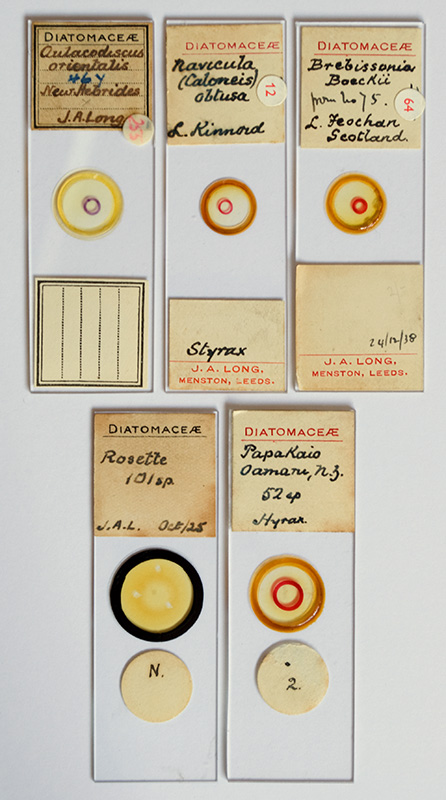
The two lower slides are the exhibition arrangement and systematic arrangement possessed, these and the genera series below do not have address labels, but the 'Rosette' is labelled 'J.A.L.' which is also seen on other slides without address label. Unusually, they both retain the original slide notes (and map for the 'Rosette') written by Long and are shown below. (See
Appendix for full species / locality list).
Single species slides
The three examples of single species slide possessed seem typical of those found, judging from regular online slide sales and the large collection sold by Bonham auctioneers (mentioned above). These may include a single selected specimen as shown by the Auliscus species below, or presentation of a small number of selected
specimens as shown for the Navicula and Brebissonia species.

The single species slide Aulacodiscus orientalis, New Hebrides (now Vanuatu, S. Pacific). This slide has a single selected specimen.
Zeiss 25/0.6 Neofluar, brightfield, 9 image stack with the freeware Combine ZP.
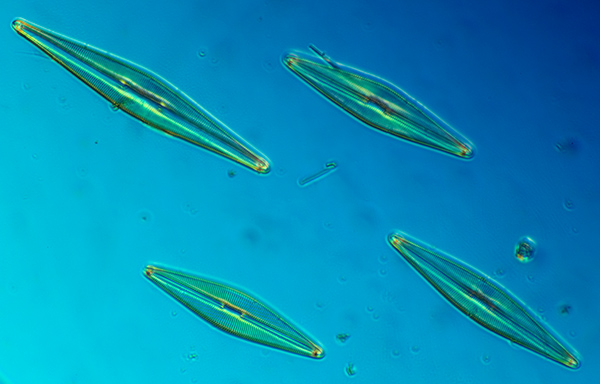
Single species slide. Four neatly arranged specimens of Brebissonia boeckii, Loch Feochan, Scotland
(a west coast sea loch south of Oban). Zeiss 25X NA0.60 Neofluar objective.
(DIC with lambda tint plate. The objective isn't ideal for DIC and gives a graded background.)
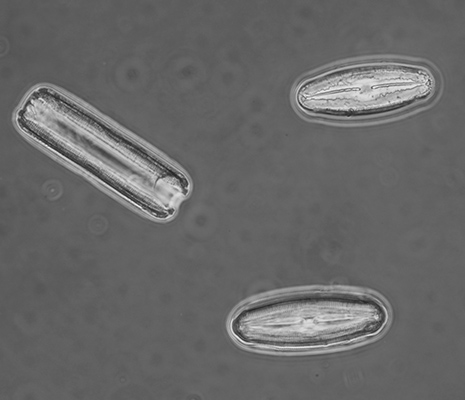
Single species slide. Three specimens of 'Navicula (Caloneis) obtusa, L. Kinnord' (sic), Scotland.
Two aspects of the frustule orientation are shown.
(L. Kinord is an inland loch west of Aberdeen at foot of the Cairngorms). Zeiss 25X NA0.60 Neofluar objective in phase.
PapaKaio 52 species slide in Hyrax
The original species list and images of the slide are shown below. Long has skilfully and attractively arranged the species in three rows. Some of the species are presented in different orientations to illustrate the frustule morphology. PapaKaio (also known as Flume Gulley) is one of the sites at the famous diatomite deposits of Oamaru, New Zealand. Bill Dailey on his web page 'Oamaru Diatomite Collection Sites' describes and illustrates many of the sites.

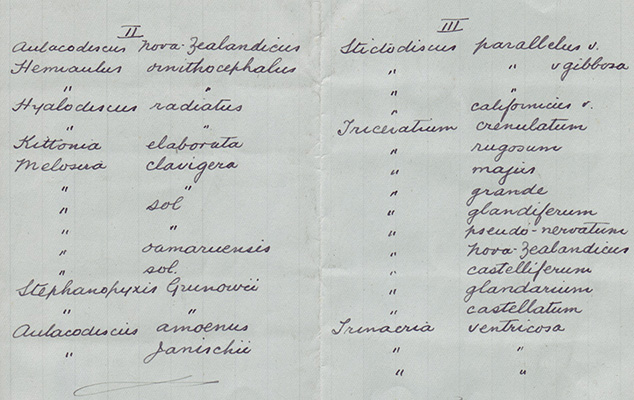
The original species list by Long for his PapaKaio, Oamaru 52 species slide.

The 52 species slide in brightfield, Zeiss 2.5x NA0.16 planachro objective.

The 52 species slide in darkfield, Zeiss 2.5x NA0.16 planachro objective.
The 'Rosette' 101 specimen, 13 species slide, dated October 1925.
The species map and images of this strikingly arranged slide are shown below. Long would have been retired for two years when he made this slide. Unlike the slide above, species were sourced from a variety of locations which are given on the map. The name of the house 'Ferncliffe' on the letter paper used for the map is an earlier address, he later lived in 'Mayhurst' (10); both houses were on Cleasby Road, Menston.
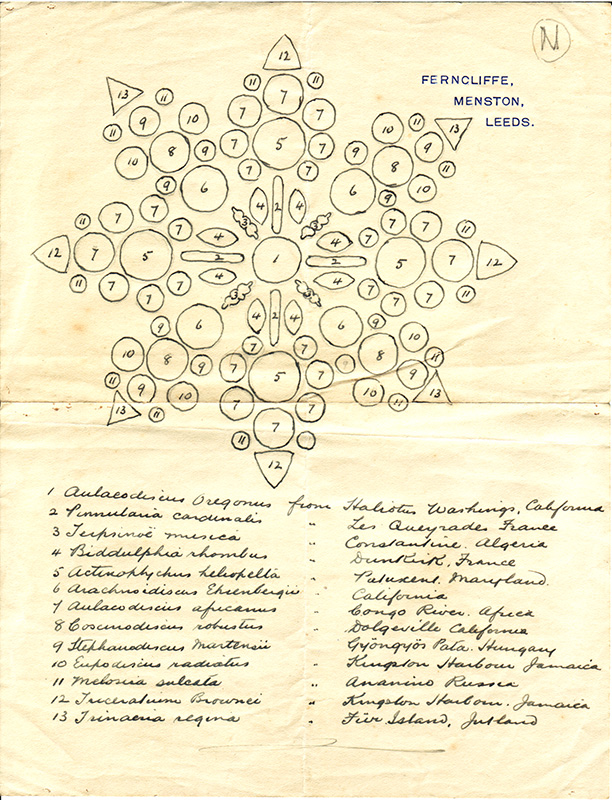
The original 'map' and species list by Long for his 'Rosette' 13 species (101 specimens) slide. Presumably of same date as that of slide October 1925.
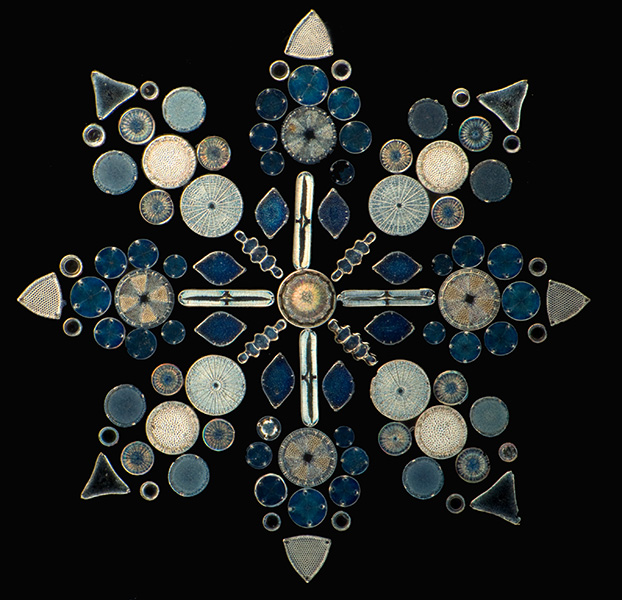
The Rosette slide in darkfield, Zeiss 2.5X NA0.16 planachromatic objective. Black background fill. The arrangement uses the geometric forms of the different species to great effect. There can be some movement of diatoms on slides with age or with coverslip percussion, a little movement may have occurred for the central Pinnularia cross.
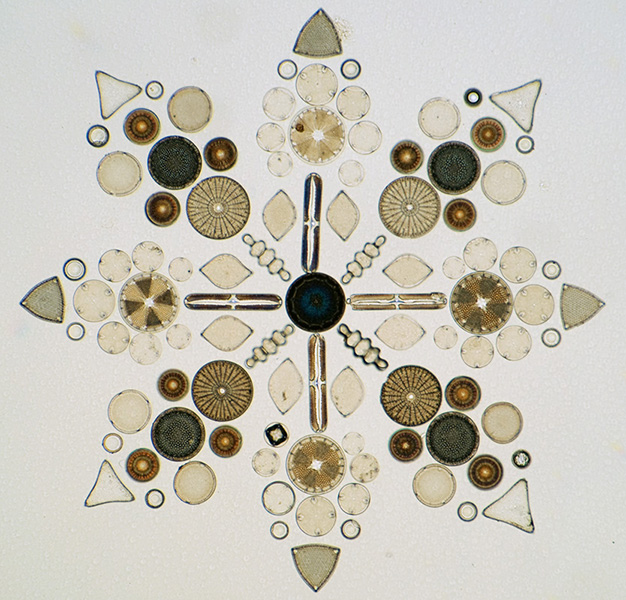
The Rosette slide in brightfield with same objective. The mountant has become slightly granular over time but does not detract from the fine workmanship.
It may be a coincidence, but browsing though Bracegirdle's extensive colour plates of slides in his book 'Microscopical Mounts and Mounters' (1), the only other mounter with a similar (but not identical) double label, red ink and font is the diatomist Dingley Fuge who as remarked lived close by and was a co-author of the Moreno Shale paper. Perhaps they used the same printer and/or chose similar label styles.
'Diatomaceae Six Generic Slides'
This is a set of 'Six Generic Slides' by Long accompanied by the original neatly hand sewn booklet with an immaculately handwritten list of species and their collection site for each slide. For an owner today, some connection with a slide mounter is experienced by handling slides and if handwritten labels, but for slides to be accompanied by such splendid original notes is a particular
pleasure—and unusual—slides over the years can often be separated from notes to accompany them. (See Appendix for full species / locality list).
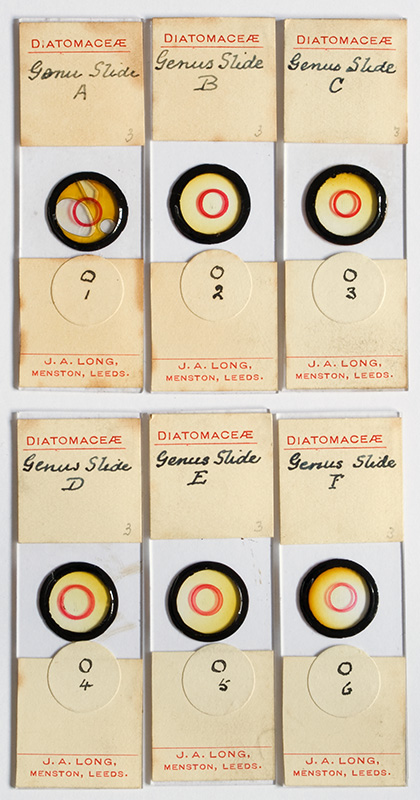
The six slides have the typical Long double labels. Sadly slide A has been damaged and/or the mountant has suffered in its life.
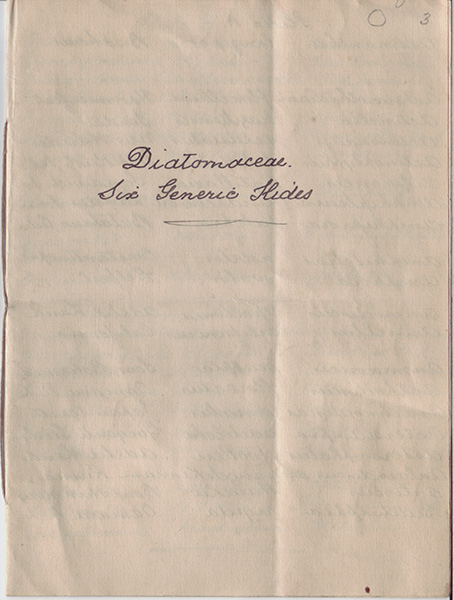
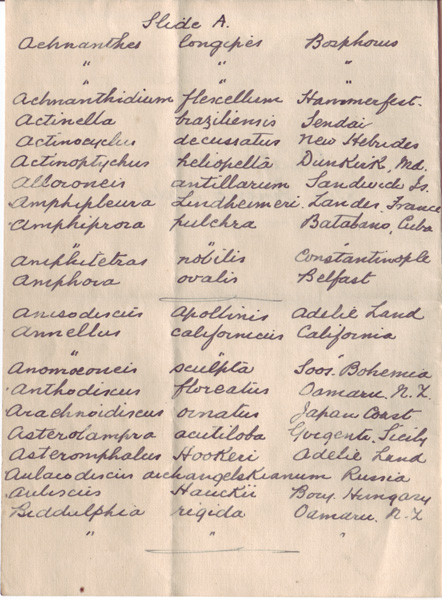
The front page and a typical page listing the species; this example for slide A. The spacer line indicates the end of first row.
The slides are shown below in brightfield using the Zeiss 4x NA0.16 planapo objective. Long has neatly arranged the species in two rows on each slide with six to fourteen specimens per row. The frustules are set on a line along the midpoint of their axes. Species from many evocative sampling locations are included. As for the 52 species slide, some species are shown in different orientations to show the frustule
morphology.
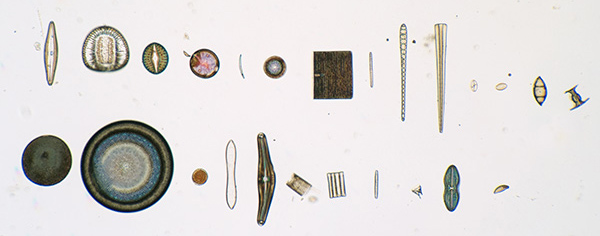
Genus Slide B - some likely specimen movement has occurred.
The Cocconeis seticola (10th and 11th sp., 1st row) was collected from 'Antarctic whales'.'
| Genus |
Species |
Location |
Country |
Row |
No. in row |
| Caloneis |
permagna |
Connecticut |
USA |
1 |
1 |
| Campylodiscus |
clypeus |
Loos |
Bohemia |
1 |
2 |
| Campylodiscus |
grevillei v. regalis |
California |
USA |
1 |
3 |
| Cerataulus |
orbicularis |
|
Abyssinia |
1 |
4 |
| Ceratoneis |
arcus |
Appleby |
England |
1 |
5 |
| Cestodiscus |
superbus |
Newcastle |
Barbados |
1 |
6 |
| Climacosira |
mirifica |
|
Rodriguez |
1 |
7 |
| Climacosira |
mirifica |
|
Rodriguez |
1 |
8 |
| Climacosphenica |
australis |
Port Philip |
Australia |
1 |
9 |
| Climacosphenica |
australis |
Port Philip |
Australia |
1 |
10 |
| Cocconeis |
seticola |
Whales |
Antarctica |
1 |
11 |
| Cocconeis |
seticola |
Whales |
Antarctica |
1 |
12 |
| Corunna |
elegans |
Jutland |
Denmark |
1 |
13 |
| Corunna |
elegans |
Jutland |
Denmark |
1 |
14 |
| Coscinodiscus |
tumidus v. lineatus convexus |
|
Russia |
2 |
1 |
| Craspedodiscus |
elegans |
Dunkirk, Indiana? |
USA |
2 |
2 |
| Cyclotella |
striata |
Hanover |
Germany? |
2 |
3 |
| Cymatopleura |
solea |
Hillingdon, Middlesex |
England |
2 |
4 |
| Cymbella |
mexicana |
Laran Is? Oregon |
USA |
2 |
5 |
| Dactyliosolen |
antarctica |
Surface |
Antarctica |
2 |
6 |
| Diatoma |
anceps |
Pyrenees |
France? |
2 |
7 |
| Diatoma |
anceps |
Pyrenees |
France? |
2 |
8 |
| Decladia |
capreolus |
Baltic Sea |
Sweden? |
2 |
9 |
| Diploneis |
giebelii |
Palos Verdes, California |
USA |
2 |
10 |
| Encyonema |
prostratum |
Yorkshire |
England |
2 |
11 |
Genus Slide B species list
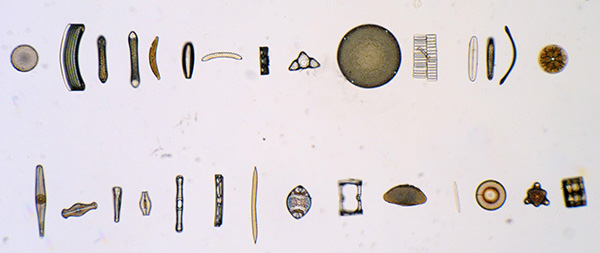
Genus Slide C.
| Genus |
Species |
Location |
Country |
Row |
No. in row |
| Endictya |
oceanica |
Viscaino Bay, California |
USA |
1 |
1 |
| Entopyla |
australis |
California |
USA |
1 |
2 |
| Entopyla |
australis |
California |
USA |
1 |
3 |
| Entopyla |
australis |
California |
USA |
1 |
4 |
| Epithemia |
hyndmannii |
L. Bearg, Skye |
Scotland |
1 |
5 |
| Epithemia |
hyndmannii |
L. Bearg, Skye |
Scotland |
1 |
6 |
| Eunotia |
robusta |
Essex. Massachusetts |
USA |
1 |
7 |
| Eunotogramma |
weissii |
|
Russia |
1 |
8 |
| Eunotogramma |
weissii |
|
Russia |
1 |
9 |
| Eupodiscus |
radiatus |
Tampa Bay, Florida |
USA |
1 |
10 |
| Fragilaria |
virescens |
Meudon |
France |
1 |
11 |
| Frustulia |
lewisiana |
Canned fish |
China |
1 |
12 |
| Gephyria |
media |
|
Sandwich Is. |
1 |
13 |
| Gephyria |
media |
|
Sandwich Is. |
1 |
14 |
| Glorioptychus |
callidus |
California |
USA |
1 |
15 |
| Gomphoneis |
mamilla |
Swan Lake, Oregon |
USA |
2 |
1 |
| Gomphonema |
geminalino? |
Inverness |
Scotland |
2 |
2 |
| Gomphonema |
geminalino? |
Inverness |
Scotland |
2 |
3 |
| Goniothecium |
odontella |
Oamaru |
New Zealand |
2 |
4 |
| Grammatophora |
robusta |
Redondo Beach |
USA |
2 |
5 |
| Grammatophora |
robusta |
Redondo Beach |
USA |
2 |
6 |
| Hantzschia |
vivax v. granulata |
Bristol, Connecticut |
USA |
2 |
7 |
| Hemiaulus |
vergata |
Oamaru |
New Zealand |
2 |
8 |
| Hemiaulus |
vergata |
Oamaru |
New Zealand |
2 |
9 |
| Hemidiiscus |
cuneiformis |
Lompoc. California |
USA |
2 |
10 |
| Homoeoeladia |
vidovichii |
|
Palestine |
2 |
11 |
| Hyalodiscus |
radiatus |
|
Kerguelen |
2 |
12 |
| Hydrosera |
whanipoensis |
Tamar River |
Jamaica |
2 |
13 |
| Hydrosera |
whanipoensis |
Tamar River |
Jamaica |
2 |
14 |
Genus Slide C species list

Genus Slide D
| Genus |
Species |
Location |
Country |
Row |
No. in row |
| Isthmia |
nervosa |
Viscaino Bay, California |
USA |
1 |
1 |
| Isthmia |
nervosa |
Viscaino Bay, California |
USA |
1 |
2 |
| Kittonia |
granulata |
Kamischco |
Russia |
1 |
3 |
| Kittonia |
granulata |
Kamischco |
Russia |
1 |
4 |
| Leudogeria |
janischii |
|
New Hebrides |
1 |
5 |
| Licmophora |
ehrenbergii |
Thursday Island |
Australia |
1 |
6 |
| Mastogloia |
lanceolata |
|
France |
1 |
7 |
| Mastogloia |
lanceolata |
|
France |
1 |
8 |
| Melosira |
clavigeia |
Oamaru |
New Zealand |
1 |
9 |
| Meridion |
curculare |
Yorkshire |
England |
1 |
10 |
| Navicula |
praetexta |
Palos Verdes, California |
USA |
1 |
11 |
| Neidium |
tumescens |
Troy, New Hamphire |
USA |
1 |
12 |
| Nitzschia |
scalaris |
Connecticut |
USA |
1 |
13 |
| Odontotropis |
carusiata |
Jutland |
Denmark |
2 |
1 |
| Odontotropis |
carusiata |
Jutland |
Jutland |
2 |
2 |
| Orthoneis |
splendida |
|
Denmark |
2 |
3 |
| Pantocsekia |
clivosa |
Kekko |
Hungary |
2 |
4 |
| Pantocsekia |
clivosa |
Kekko |
Hungary |
2 |
5 |
| Pinnularia |
episcopalis |
Ongaroto Valley |
New Zealand |
2 |
6 |
| Plagiodiscus |
nervalis |
|
New Hebrides |
2 |
7 |
| Pleurodesmium |
brebissonii |
Demerara |
Guyana |
2 |
8 |
| Pleurodesmium |
brebissonii |
Demerara |
Guyana |
2 |
9 |
| Pleurosigma |
attenuatum |
Lake of Four, Caulour? |
USA |
2 |
10 |
| Podocystis |
adriaticus |
|
New Hebrides |
2 |
11 |
| Polymyxus |
coronalis |
Para River |
Brazil |
2 |
12 |
| Polymyxus |
coronalis |
Para River |
Brazil |
2 |
13 |
| Porodiscus |
oblongus |
Mt. Hillaby |
Barbados |
2 |
14 |
Genus Slide D species list
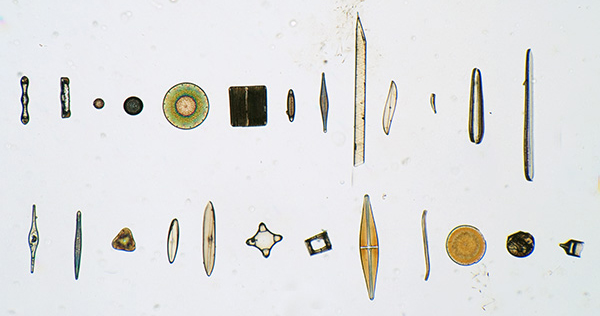
Genus Slide E
| Genus |
Species |
Location |
Country |
Row |
No. in row |
| Porpeia |
quadriceps |
Newport, California |
USA |
1 |
1 |
| Porpeia |
quadriceps |
Newport, California |
USA |
1 |
2 |
| Pseudo-stictodictus |
angulatus |
Jutland |
Denmark |
1 |
3 |
| Pyxidicula |
crucata |
Oamaru |
New Zealand |
1 |
4 |
| Rattrayella |
oamaruensis |
Carlovo |
Russia |
1 |
5 |
| Rhabdonema |
arcuatum |
San Sebastian |
? |
1 |
6 |
| Rhabdonema |
arcuatum |
San Sebastian |
? |
1 |
7 |
| Rhaphoneis |
amphicerio? |
Atlantic City |
USA |
1 |
8 |
| Rhizosolenia |
styliformis |
Cape of Good Hope |
S. Africa |
1 |
9 |
| Rhoicosigma |
compactum |
|
Samoa |
1 |
10 |
| Rhoicosphenia |
curvata |
Puy de Dome |
France |
1 |
11 |
| Rhopalodia |
vermicularis |
|
Abyssinia |
1 |
12 |
| Rhopalodia |
vermicularis |
|
Abyssinia |
1 |
13 |
| Ruhlaria |
epsilon |
Yeso |
Japan |
2 |
1 |
| Sceptroneis |
caduceus |
California |
USA |
2 |
2 |
| Sehuettia |
amblyocerus |
Il. Laurent |
France |
2 |
3 |
| Scoliopleura |
tumida |
Il. Servan |
France |
2 |
4 |
| Scoliotropis |
latestriata |
Puget Sound |
USA |
2 |
5 |
| Solium |
exsculptrum |
Jutland |
Denmark |
2 |
6 |
| Solium |
exsculptrum |
Jutland |
Denmark |
2 |
7 |
| Stauroneis |
phoenicenteron |
Connecticut |
USA |
2 |
8 |
| Stenopterobia |
anceps |
Il. Leger |
France |
2 |
9 |
| Stephanodiscus |
carconensis |
Klamath Falls |
USA |
2 |
10 |
| Stephanogonia |
danica |
Jutland |
Denmark |
2 |
11 |
| Stephanogonia |
danica |
Jutland |
Denmark |
2 |
12 |
Genus Slide E species list
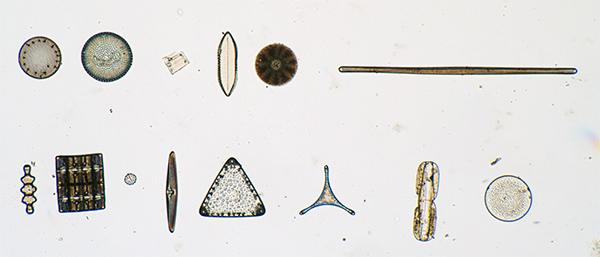
Genus Slide F
| Genus |
Species |
Location |
Country |
Row |
No. in row |
| Stephanophyxis |
diadema |
Dunkirk, Maryland |
USA |
1 |
1 |
| Stictodiscus |
californicus |
Palos Verdes, California |
USA |
1 |
2 |
| Striatella |
unipunctata |
Port Philip |
Australia |
1 |
3 |
| Striatella |
fullebonnii |
|
Abyssinia |
1 |
4 |
| Symbolophora |
trinitatis |
Carlovo |
Russia |
1 |
5 |
| Synedra |
superba |
|
Black Sea |
1 |
6 |
| Terpsinoe |
musica |
|
Martinique |
2 |
1 |
| Terpsinoe |
musica |
|
Martinique |
2 |
2 |
| Tetracyclus |
japonicus |
Sendai |
Japan |
2 |
3 |
| Trachyneis |
debyi |
Samarang |
Java |
2 |
4 |
| Triceratium |
majus |
Oamaru |
New Zealand |
2 |
5 |
| Trinacria |
excavata |
Jutland |
Denmark |
2 |
6 |
| Tropidoneis |
maxima |
Port Philip |
Australia |
2 |
7 |
| Xanthiopyxis |
umbonata |
Sendai |
Japan |
2 |
8 |
Genus Slide F species list
Comments
The diatom studies of John Albert Long, do not seem to be as widely known as that of the great 19th and 20th century workers on the group. Apart from Hendey's Obituary of Long, searches to date haven't revealed any articles discussing aspects of Long's life and diatom studies (any references known welcomed).
Examples of his single species slides exist both in private hands and owned by institutions and individual examples occur regularly for sale online. What isn't clear from searches to date is whether Long sold a selection of these slides as no adverts have been found to date. The Rosette, 52 species and generic slides which I own with accompanying species list have been painstakingly prepared, whether these more
time
intensive slide preparations with map / lists were made solely for his own use or for selected friends and / or colleagues is uncertain.
Although I own only eleven slides, eight are multi-species with 213 specimens, which allows some assessment of the sample locations from which Long had received samples. Approximately 94 locations are given for these specimens from all over the world and illustrate the breadth of material which Long was acquiring and preparing into slides. See Appendix 2 for list of species with collection location.
The catalogued collection of over 1000 slides prepared especially for the Royal Microscopical Society should prove fascinating to explore; providing more extensive information on the breadth of species mounted, their collection locations and whether any examples of arranged exhibition or systematic slides, such as those shown above. Sourcing a complete series of the, to date, elusive 'Journal of the
Spen Valley Literary and Scientific Society' may reveal articles written by Long on his local diatom flora. As long time Secretary to the Society (2) he may have particularly supported this publication with his work. The correspondence of Long throughout his diatom studies must have been extensive, whether this still exists is uncertain but should prove an invaluable resource if it does and can be sourced. Or studying the correspondence still extant of those workers both in the UK and around the world
with whom he liaised e.g. Dingley P. Fuge, Norman I. Hendey, William A. Firth and James Smith in the US.
The Obituary by Hendey and comments of other workers clearly indicates the very high esteem in which his work was held. His extensive paper which he co-authored on the diatom flora of the Moreno Shale describing ca. 67 new species, three requiring new genera, is frequently cited to this day (from online citation searches) and his many remaining prepared slides are together a testament
to and fitting legacy of his work.
Comments to the author David Walker are welcomed.
Acknowledgements
I would like to thank the following people for their invaluable help while preparing this article. However, any errors or omissions and opinions expressed are solely the present author's.
- Steve Gill for sharing his own extensive independent study of the ancestry of the Long and wider family which added valuable records to the author's own study. Discussions of the inconsistencies in the reports of Long's death highlighted the need to confirm the reported date.
- Brian Stevenson for sourcing a copy of one reference.
- Members of the Yahoo diatom_forum for sourcing copies of other references.
- Chris Young, Honorary Librarian of the Yorkshire Naturalist's Union for checking the YNU library for the 'Spen Valley Soc.' Journal.
- Tony Simcock, Archivist and Stephen Johnston, Assistant Keeper at the Museum of the History of Science, Oxford for their valued help and insight into the current location of the RMS slide collections and for the link to the museum database and search methods, which provided the key lead to locate the slides donated by Long.
- Jo Wilbraham, Curator of Algae, Botany Dept., Natural History Museum, London, for checking their catalogues for slides attributed to J A Long.
- Klaus Kemp for providing fascinating background information on the Long collection of diatom samples of which he is custodian.
- Brian Davidson for his slide sales which extended my own collection of Long slides.
- The staff at the West
Yorkshire Archive Services for checking the 'Spen Valley' Society holdings and
for providing a copy of Long's 'Local Diatoms' article.
- Cheshire Archives and Local Studies staff at the Cheshire Record Office for providing details of records held of the former Chester Diocesan Training College. Also for providing the 1882 class photo, permission to publish it, and report of their searches of the records.
Footnotes
1. West Yorkshire Archive Services (WYAS) holds records
of the now dissolved 'Spen Valley Society' (minutes, accounts etc) but
catalogues no complete series of the Journal, neither do local university
libraries, the library of the Yorkshire Naturalist's Union nor the British
Library. WYAS did find a catalogue record of four issues of the Journal with
other Society records: Vol 1, no. 1 Jan 1909; no. 2 Jan 1910; no. 5 Aug 1920
and no. 6 July 1924. (Catalogue
entry S/SLS/15 also additional Society material at entry KC576.)
2. The Museum of the History of Science, Oxford, online
'Small World, Specimens and Slides' catalogue lists 24 slide
drawers from the keyword search 'J.A. Long'.
Inv. number 62954, drawer IDs
329 - 350 inclusive and 447, except drawer IDs 332-334. Total slides 1027, all
by Long. The catalogue entry for each drawer includes the typical note:
"contains [number] slides, all of Diatoms, made by J.A. Long, Menston,
Leeds, dating to 1930s".
Inv. number 62954, drawer IDs 396, 399, 401, 432.
Total slides 211, cataloguing slides by various makers, including diatom slides
by J.A. Long, the catalogue entry for some drawers states that Long's are
the dominant type of slide.
3. The records of the former Chester Diocesan Training
College are held at the Cheshire Record Office and covers the years John Long would
have attended. The collection is held under reference 'ZCR 86'.
Appendix 1 - Inconsistencies in the reported year of death of John Albert Long (1944 or 1945?). (Compiled with the aid of contributions from, and discussions with, Steve Gill.)
After completing my own researches on Long's family background, I had invaluable discussions with Steve Gill who had earlier undertaken a more extensive study of Long's immediate / wider family background (12) and who had noted an inconsistency in two records for Long's year of death, one reported 1944 another 1945. These were confirmed by my own searches and our joint findings are summarised below.
|
Reports of Long's death in 1944
|
Reports of Long's death in 1945
|
| 'N.I.H's (Norman Ingram Hendey) Obituary for John Albert Long headed '(1863 - 1944)', states died on June 5th but doesn't mention year in text, suggesting the year was the same as Journal issue publication. |
The 'Moreno Shale' paper authored by Long and co-workers dated March 1946 in J. of Paleontology (5), states in header that Long was 'deceased, 1945'. |
| Obituary was published in Journal of the Royal Microscopical Society, issue dated Sep - Dec, 1944, (vol. 64, issue 3-4). |
Official death registry entry is in the volume for end of Apr - Jun quarter 1945. |
| An Obituary in same 1944 dated issue of the famous paleontologist Frederick Chapman refers to him dying 'on December 10th last', i.e in December 1943, this is correct from many other records. Suggesting Journal dating is correct. |
Burial record from local church states buried a few days after death (on June 5th) on June 9th 1945 (15). |
|
Entries for Long in references 1 and 16.
There's no reason why later references to his death should doubt the apparently consistent 1944 Journal Obituary entry, compounded by a genuine 1944 Obituary entry
for Chapman being included with that for Long one year later.
|
Confirmation: Official copy of death certificate for above registry record confirms death June 5th 1945. (14)
Stated age at death of 82 also consistent with his birth date on January 25th 1863. (Although age alone is not always reliable evidence in ancestry records.)
|
A copy of Long's death certificate confirms his death on June 5th 1945; his former occupation, age at death and address on certificate confirm it is the correct record. The official records i.e. death certificate, registry entry and burial record are therefore consistent and take precedent. The 1944 records of Long's death seem to have arisen from Hendey's Obituary published in a later Journal
issue but dated 1944 and with an incorrect Obituary header '(1863 - 1944)'; the latter error may not have been Hendey's. Publication of the RMS Journal issues near and at the end of World War II could have been delayed for very legitimate reasons, but for consistency, maintaining serial numbering from an earlier date.
Such a 'time shift' between the true date of some Journal content and the date on a Journal issue can also be seen in the following 1945 issue; Journal of the Royal Microscopical Society, 1945, vol. 65, November, issue 1-4, it has a review of the first edition of the book published in 1947 entitled 'The Intelligent Use of the Microscope.— C W Olliver. 1947.'
Appendix 2 - Full species and collection location list for slides owned
An Appendix containing details of all the slides owned is presented on a separate page in alphabetical order of species. 213 specimens from ca. 94 distinct locations, presented on 11 slides (not including multiple species used on the arranged Rosette slide).
References and Resources
1. B. Bracegirdle, 'Microscopical Mounts and Mounters', Quekett Microscopical Club, 1998. Entry for 'LONG, J. A.', p.64.
1a. ibid, entry for 'FUGE D. P., p.44.
1b. ibid, entry for 'KEMP K. D., p.59.
1c. ibid, entry for 'FIRTH, W. A.', p.37.
1b. ibid, entry for 'FLATTERS AND GARNETT LTD.', p.39-41.
2. 'Obituary John Albert Long. (1863-1944)' signed 'N.I.H.' i.e. Norman Ingram Hendey, Journal of the Royal Microscopical Society, 1944, vol. 64, (3-4), 167. Issue dated 1944 but published later, See Appendix 2.
2a. Obituaries for Norman Ingram Hendey were published in the Phycologist, 2005, 68 (Spring), p. 10-11 by Gerald Boalch (free access) and Diatom Research, 2005, vol. 20. no. 2, pp. 417-424.
3. Ancestry record searches: The author's own using 'Find my Past' website - birth, marriage and death records and censuses up to 1911. Supplemented by the more extensive and wider family records compiled by Steve Gill.
3a. Marriage record, General Register Office, UK. Entry -
Grantham, 1911, 2nd quarter, vol. 7A, p.1246. Record from Steve Gill's ancestry searches of the Long family.
4. American Journal of Education by Henry Barnard, Volume 10. XI 'Training college for the Diocese of Chester.' An extensive entry with details
on the College and its courses.
5. John A. Long, Dingley P. Fuge and James Smith, 'Diatoms of the Moreno Shale', Journal of Paleontology, 1946, vol. 20, no. 2 (March), 89-118.
6. B. Bussey, 'Obituary. The Rev. Dingley P. Fuge', The Microscope, vol. 5, no. 10. p.267. Includes photograph of Fuge.
7. Klaus Kemp, UK, personal communication.
8. e.g. Journal of the Royal Microscopical Society, 1933, vol. 59-60. "Mr. JA Long, FRMS— 56 species slides of diatoms." Others from snippet views of Journal issues from Google Books using 'J A Long' or 'John A Long' and 'diatoms' search.
9. Tony Simcock, Archivist at the Museum of the History of Science, Oxford, personal communication.
10. Afrilib "index to Schmidt's Atlas of Diatoms", library catalogue entry, "Notes - Copied from manuscript copy of Fricke's Index (plates 1-240), and
manuscript index to plates 241-376; both lent by Mr John A. Long, Mayhurst",
Menston, Yorkshire."
11. N. Ingram Hendey, 'II New Species of Diatoms', Journal of the Royal Microscopical Society, 1939, vols. 59-60, p.11. '... six species were received from Mr. J. A. Long'.
12. Steven Gill, UK, personal communications.
13. Baptismal record for John Albert Long, also recording birth, St John's Church, Yeadon, 1863, entry no. 848, page 106. Reference supplied by Steve Gill.
14. John Albert Long, certified
copy of death certificate, General Register Office, UK. Entry -
Wharfedale, 1945, 2nd quarter, vol. 09A, p.165.
15. Burial record for John Albert Long, St Mary's Church, Burley in Wharfedale, 1945, entry no. 79, page 10. Reference supplied by Steve Gill. (Coincidentally, the next burial entry no. 80 is for Harriet Switherbank whose address is given as Ferncliffe, Cleasby Road, Menston, where John Long formerly lived.)
16. R. Desmond 'Dictionary of British and Irish Botanists and Horticulturists', 1994, CRC Press, entry 'Long, John Albert (1863 - 1944). Reference supplied by Steve Gill.
17. Written report of a search of the relevant Chester Diocesan Training College archives listed in Footnote 3, kindly carried out by Cheshire Archives and Local Studies staff.
Revision history:
December 13th, 2011: Published.
December 16th 2011: Footnote 3 added on Cheshire Record Office archive for the former Chester Diocesan Training College.
December 17th 2011: Some dates in 'Work on Diatoms' section corrected.
January 24th 2012: Note added on Long's 'Journal of the Spen Valley ... '
article and links to the West Yorkshire Archive records of the
Society.
March 12th 2012: Search results of Chester Diocesan Traiing College archives added; i.e. photo of Long in 1882 and notes on his course.
©
Microscopy UK or their contributors.
Published
in the December 2011 edition of Micscape.
Please
report any Web problems or offer general comments to
the
Micscape
Editor
.
Micscape
is the on-line monthly magazine of the Microscopy UK web
site at
Microscopy-UK
©
Onview.net Ltd, Microscopy-UK, and all contributors 1995
onwards. All rights reserved.
Main site is at
www.microscopy-uk.org.uk.


























